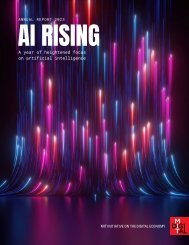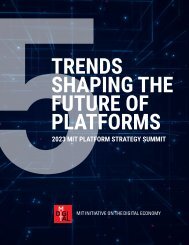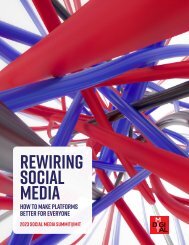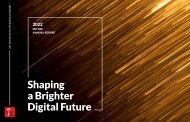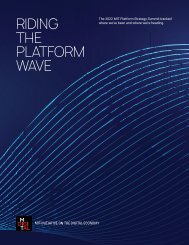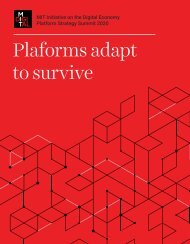You also want an ePaper? Increase the reach of your titles
YUMPU automatically turns print PDFs into web optimized ePapers that Google loves.
<strong>Platform</strong>s Mean<br />
Business<br />
Tomorrow’s business model meets today’s challenges<br />
PLATFORM<br />
STRATEGY<br />
SUM<strong>MIT</strong> <strong>2021</strong>
A Year of Business<br />
Reinvention<br />
In <strong>2021</strong>, it seems that whatever the business problem,<br />
platform markets offer a solution.<br />
“Firms that implemented an end-to-end<br />
digital infrastructure were much more nimble<br />
and able to deal with disruptive supply and<br />
demand. It gave them the option to deal with<br />
pandemic-driven disruption.”<br />
From unequal labor supply and demand<br />
to innovation and green energy, platform<br />
ecosystems are attracting new business<br />
partners, streamlining operations, and<br />
optimizing digital technologies.<br />
As businesses try to emerge from COVID-19<br />
shut-downs and shake-ups, integration with<br />
existing platforms is gaining acceptance<br />
in traditional industries. While challenges<br />
remain, platforms provide rapid access to<br />
new products and services, transparency,<br />
and global collaboration. Businesses no<br />
longer have to go it alone.<br />
At the ninth annual <strong>MIT</strong> <strong>Platform</strong> Strategy<br />
Summit, industry experts described the<br />
expansion of B2C markets and also the<br />
growth of platforms in longstanding B2B<br />
industries. The virtual Summit attracted<br />
more than 500 top-level executives,<br />
academics, and analysts who came together<br />
to examine global trends and policies. They<br />
were able to network and listen to musical<br />
breaks thanks to platforms, too. “CEOs and<br />
tech leaders with the foresight to invest in<br />
digital platforms prior to the pandemic now<br />
find their businesses more agile and better<br />
able to pivot and adapt to change,” according<br />
to Summit Co-chair Geoffrey Parker.<br />
The shift to B2B platforms isn’t new,<br />
but it has accelerated as a result of the<br />
dual disruptions of the pandemic and<br />
climate change. Incumbent industries,<br />
such as manufacturing and energy, must<br />
integrate technology-forward platforms<br />
into their business operations to compete,<br />
meet sustainability requirements, and<br />
remain profitable.<br />
Concurrently, Asian platform innovation<br />
is exploding and offering a window into<br />
emerging trends. In the Western Hemisphere<br />
regulation and resistance have stemmed<br />
these models to some extent, but the<br />
emergence of Asian “super apps” will have<br />
lasting impact.<br />
Geoffrey Parker<br />
Professor, Dartmouth College<br />
Digital Fellow, <strong>MIT</strong> IDE<br />
Summit Co-Chair<br />
RELATED RESEARCH<br />
For more details on the topics covered at the<br />
Summit, check out these five research papers<br />
and others at ide.mit.edu.<br />
<strong>Platform</strong> Pricing and Investment to Drive Third Party<br />
Value Creation in Two-Sided Networks<br />
Anderson, Parker, and Tan<br />
Preparing the Next Generation of <strong>Platform</strong> Leaders<br />
Evans, Parker, Van Alstyne, and Finkhousen<br />
How Users Drive Value in Network Markets<br />
Van Alstyne, Zhang, and Zhou<br />
CONTENTS<br />
03. The <strong>Platform</strong> Economy: An Ever-Changing Map<br />
03. B2C <strong>Platform</strong>s Make Way for B2B<br />
04. Regulation Aims at Monopolies<br />
04. Fintechs and Digital Banks<br />
05. Suppy and Demand Shocks Reverberate<br />
06. <strong>Platform</strong>s Fuel the Great Energy Transition<br />
07. A Conversation with Kai-Fu Lee<br />
08. Competition via Business Model Innovation<br />
09. <strong>Platform</strong>s Settle Into the Steel Industry<br />
10. Takeaways and Trends<br />
10. <strong>Platform</strong>s in Play at <strong>2021</strong> Summit<br />
10. Thanks + Acknowledgments<br />
Watch video of the <strong>2021</strong><br />
<strong>MIT</strong> <strong>Platform</strong> Summit<br />
How APIs Create Growth by Inverting the Firm<br />
Benzell, Van Alstyne, and Hersh<br />
<strong>Platform</strong> Mergers & Antitrust<br />
Parker, Van Alstyne, and Petropoulos<br />
02
FORECAST<br />
The <strong>Platform</strong> Economy:<br />
An Ever-Changing Map<br />
Peter Evans<br />
Managing Partner<br />
<strong>Platform</strong> Strategy Institute<br />
Summit Co-Chair<br />
As the platform economy has<br />
expanded, it has also become more<br />
complex to map. Summit Co-chair<br />
Peter Evans said it’s helpful to<br />
consider trends in three buckets:<br />
What we are seeing now; what<br />
we’re beginning to see, and what is<br />
on the horizon.<br />
One significant trend is the movement<br />
of major industrial companies into<br />
adjacent markets via platform<br />
strategies. The Oren Partnership<br />
between Shell and IBM to create a B2B<br />
marketplace for the mining sector,<br />
is a prime example. Direct platform<br />
partnering offers both sides broader<br />
networks and data access while<br />
simplifying transactions, Evans said.<br />
Another trend is a growing number<br />
of large-scale platform-to-platform<br />
integrations. Take Shopify and TikTok,<br />
for example. The two mega platforms<br />
joined forces so that Shopify’s 1.75<br />
million merchants can leverage<br />
TikTok to gain direct access to<br />
TikTok creators. This opens up a new<br />
marketing approach for Shopify<br />
TikTok currently boasts 1.5 billion downloads, and<br />
500 million active users—an immense opportunity<br />
for marketers to reach young consumers.<br />
merchants as well as access to one<br />
of the fastest-growing and attractive<br />
global consumer networks. TikTok<br />
currently boasts 1.5 billion downloads,<br />
and 500 million active users—an<br />
immense opportunity for marketers to<br />
reach young consumers.<br />
As for trends we are beginning to see,<br />
Evans pointed to the rise of platforms<br />
that mint and sell non-fungible<br />
tokens (NFTs). These tokens are a<br />
blockchain innovation that offers a<br />
license to digital art, a music file, or<br />
anything unique that can be stored<br />
digitally. NFT marketplaces let creators<br />
sell blockchain-enabled NFTs to<br />
consumers, and allow consumers to<br />
auction or trade NFTs on a growing<br />
number of NFT marketplaces, such as<br />
OpenSea, Nifty Gateway, SuperRare,<br />
and NBA Top Shot. Participants have<br />
traded more than $2.5 billion in<br />
NFTs in the first half of <strong>2021</strong>, and<br />
Evans anticipates that the market<br />
will broaden in the next 18 months<br />
to two years to reach more<br />
mainstream consumers.<br />
Longer term is the global spread of<br />
“super apps.” The significance of these<br />
multi-purpose apps, Evans argued, is<br />
the bundling of whole markets within<br />
integrated apps. For the provider, it’s<br />
a way to deliver more services and<br />
attract a much larger user base, while<br />
customers gain ease-of-use. These<br />
apps got their start in China, Southeast<br />
Asia, and Africa and there are early<br />
moves by Western companies to adopt<br />
a super app strategy, including Jerry in<br />
the U.S. and Revolut in Europe.<br />
FORECAST<br />
B2C <strong>Platform</strong>s Make<br />
Way for B2B<br />
Geoffrey Parker<br />
Professor, Dartmouth College<br />
Digital Fellow, <strong>MIT</strong> IDE<br />
Summit Co-Chair<br />
Summit Co-Chair Geoffrey Parker noted<br />
that much of what we know about<br />
platforms comes from B2C markets, such<br />
as Ebay, Apple, Twitter, and Airbnb. But<br />
B2B platforms are growing at a rapid rate<br />
as illustrated by companies like Siemens,<br />
Shopify, Salesforce, and Hubspot.<br />
Parker offered several strategies for<br />
successful B2B platform investment. It’s<br />
okay to experiment and test the waters as<br />
part of a deliberate, broader rollout, he said,<br />
but think about building open networks<br />
that will transform your marketplace as<br />
well as the wider ecosystem.<br />
Parker also added that current ROI metrics<br />
can’t accurately measure today’s platforms<br />
since they are long-term investments that<br />
require a new set of value measurements<br />
to monitor growth, user engagement, and<br />
co-innovation created with partners.<br />
KEY DIFFERENCES:<br />
B2C & B2B PLATFORMS<br />
Customer needs and sales cycles B2C<br />
platforms usually move at a much quicker<br />
pace than corporate marketing groups<br />
Price and costs B2B platforms must learn<br />
how to monetize services and products<br />
while still making them accessible and<br />
taking advantage of network effects.<br />
Marketing approach Will competitors<br />
collaborate and open their apps? Will large<br />
platforms acquire smaller competitors?<br />
Product knowledge Traditional industries<br />
moving to platforms must consider<br />
sharing proprietary knowledge both<br />
internally and externally.<br />
Trust Trust underlies the success—or<br />
failure—of all platform markets.<br />
Data ownership Thorny issues about<br />
privacy, data ownership, and access<br />
may be resolved by platforms or by<br />
regulatory agencies.<br />
Interaction frequency Consumer platforms<br />
operate in always-on, 24x7 mode while<br />
B2B partners may have less frequent<br />
interaction. Requirements will vary.<br />
03
FORECAST<br />
Regulation Aims<br />
at Monopolies<br />
“Regulation is coming for big tech and we should<br />
absolutely expect more changes on the horizon.”<br />
Marshall Van Alstyne<br />
Professor, Boston University<br />
Visiting Scholar, <strong>MIT</strong> IDE<br />
Summit Co-Chair<br />
Antitrust concerns are top-of-mind,<br />
but definitions are getting muddled in<br />
Washington, D.C., according to Summit<br />
Co-chair Marshall Van Alstyne. “Some<br />
want to remove friction and give<br />
everyone equal access to data, while<br />
others want to introduce friction to<br />
give users privacy,” he said. Instead,<br />
discussions should focus on platforms<br />
as infrastructure and how that<br />
infrastructure should be regulated.<br />
To foster competition while embracing<br />
the benefit of network effects, Van<br />
Alstyne proposes a new “in situ”<br />
data right that allows users to bring<br />
algorithms to their data wherever it is<br />
resident. For instance, putting decision<br />
rights in the hands of users would let<br />
them allow Amazon to recommend<br />
books based on Facebook friends, or<br />
allow Facebook to recommend friends<br />
based on Amazon reading preferences.<br />
FORECAST<br />
Banking on Fintech<br />
Digital platforms attract new customers and providers.<br />
Pinar Ozcan<br />
Professor<br />
Saïd Business School<br />
Oxford University<br />
Van Alstyne said there are merits both<br />
for and against considering platforms<br />
as infrastructure for regulatory<br />
purposes. The positive effect is that<br />
it would grant freedom of access to<br />
everyone and would not discriminate.<br />
The negative: “It does not consider an<br />
internet economy of platforms based<br />
on network effects,” he said.<br />
It’s becoming clear that previous<br />
antitrust criteria, such as belowmarginal<br />
cost pricing and restricting<br />
output, don’t apply well to platform<br />
models, Van Alstyne said. <strong>Platform</strong><br />
prices are often free—for example,<br />
Google doesn’t restrict search and<br />
Facebook doesn’t restrict posts.<br />
Additionally, traditional goods are<br />
supplied by rival manufacturers but<br />
that’s not the case when it comes to<br />
data, since it can be shared and<br />
create value for multiple parties.<br />
Van Alstyne also offered attendees<br />
a brief summary of new <strong>MIT</strong> IDE<br />
research that’s examining how digital<br />
transformation creates value. The study<br />
explored whether internal or external<br />
uses of APIs predict greater market<br />
capitalization. The results show that<br />
firms that open external-facing APIs<br />
grew an additional 38% over 16 years<br />
relative to firms that did not use APIs.<br />
In effect, firms adopting a platform<br />
strategy and enlisting third-party<br />
developers grew at a faster pace.<br />
This huge upside does have one<br />
downside risk, Van Alstyne noted:<br />
Public APIs experienced a much<br />
greater risk of data breach.<br />
View the working paper, “How APIs<br />
Create Growth by Inverting the Firm,”<br />
to learn more.<br />
“Until recently, financial data lacked<br />
interoperability by design, and resided<br />
only in financial institutions to protect<br />
user privacy,” said Pinar Ozcan of Saïd<br />
Business School. “But as the value of<br />
data grows, regulation must dictate<br />
how data is shared and accessed.”<br />
The Rise of Open Banking<br />
Open banking provides a safe way for<br />
customers to share data through API’s,<br />
according to Ozcan. “Now, we can<br />
grant access to third party apps that<br />
analyze our data and make investment<br />
or purchasing recommendations.” Single<br />
service fintechs are beginning to ‘attack’<br />
big banks with online offerings, she said.<br />
Nevertheless, it’s still very expensive to<br />
enter the financial market today, and<br />
earning customer trust takes time. As<br />
a result, many small fintechs may<br />
find digital bank platforms to be an<br />
appealing entry point. Small companies<br />
may also find big tech firms offer an<br />
attractive option for financial market<br />
entry. For instance, Amazon has<br />
created a basic lending service for<br />
small- to medium-sized businesses,<br />
while Google is approaching the<br />
market with a data capture and analysis<br />
strategy, according to Ozcan. Facebook,<br />
meanwhile, is investing in peer-to-peer<br />
financing, providing financial services<br />
to rural areas where people have<br />
phones but little access to a bank.<br />
Ozcan also expects big tech firms<br />
to enter the healthcare market as IT<br />
providers. Once they have access to<br />
consumer data, they can invest in<br />
areas such as prediction services to<br />
healthcare providers. Data access<br />
could give tech platforms an advantage<br />
over niche players in healthcare as<br />
well as fintech.<br />
“The service providers<br />
in healthcare are not<br />
changing, however the<br />
power is shifting to big<br />
tech because they are<br />
the ones that keep the<br />
data...they use the data<br />
to provide prediction<br />
services that will help<br />
healthcare providers.”<br />
Pinar Ozcan<br />
04
ECONOMICS RESEARCH<br />
Supply and Demand<br />
Shocks Reverberate<br />
John Horton<br />
AI, Labor Economics & Online Marketplaces Research Group Leader<br />
<strong>MIT</strong> IDE<br />
Research shows impact of pandemic on platform markets.<br />
The past year has proven to be a<br />
mixed economic bag for platform<br />
companies. The pandemic led to a<br />
“negative demand shock,” meaning<br />
that there were significant decreases<br />
in demand for markets such as the<br />
travel and restaurant industries,<br />
according to <strong>MIT</strong> IDE research<br />
group leader John Horton. Hard-hit<br />
AirBnb, for example, experienced<br />
almost a complete loss in revenue<br />
during the first few months of the<br />
pandemic due to travel and social<br />
distancing restrictions.<br />
On the other hand, some platform<br />
businesses exploded as people stayed<br />
home and relied on e-commerce and<br />
food delivery services such as Uber<br />
Eats and Doordash, which saw a<br />
surge in business.<br />
Meanwhile, many workers were<br />
suddenly faced with unemployment,<br />
remote work, or working under<br />
high-risk in-person conditions. For<br />
example, Uber drivers are still required<br />
to wear masks and many have<br />
installed dividers to mitigate the risk<br />
of exposure to the virus. At the same<br />
time, some workers adapted well to<br />
platform and gig-style jobs, which led<br />
to a positive supply of remote laborers<br />
for high-demand, online services.<br />
The net result, according to Horton’s<br />
research, was a lower supply of<br />
workers and an increased demand for<br />
B2C platforms. <strong>Platform</strong>s like Uber<br />
found themselves stretched thin and<br />
service quality suffered, since fewer<br />
drivers meant longer wait times or no<br />
available rides for consumers.<br />
5 KEY LABOR<br />
TRENDS<br />
John Horton offered five trends and<br />
action items for platforms rebounding<br />
from the past year.<br />
Offer higher wages<br />
Businesses may have to raise wages to<br />
compete and maintain service quality.<br />
Think long-term<br />
Don’t ignore the second law of demand—<br />
the long run is more elastic than the short<br />
run. Even if your company saw little or no<br />
impact from the pandemic, you still may<br />
experience ripple effects longer term.<br />
New norms<br />
New norms will form around platform<br />
service integration and remote work.<br />
Urban shifts<br />
People will likely spread out from cities,<br />
which could impact platforms (like ridesharing<br />
services) that thrive on condensed<br />
geographical areas.<br />
Expect fluctuations<br />
Supply and demand will continue to<br />
fluctuate and then balance out over the<br />
next year.<br />
05
PANEL DISCUSSION<br />
<strong>Platform</strong>s Fuel the Great<br />
Energy Transition<br />
Energy leaders explain how their companies have implemented<br />
platform models and what promises lie ahead.<br />
Peter Evans<br />
Managing Partner<br />
<strong>Platform</strong> Strategy<br />
Institute<br />
Moderator<br />
Laslo Varro<br />
VP for Global Business<br />
Environment<br />
Shell<br />
Ilham Kadri<br />
CEO<br />
Solvay<br />
Cathy Zoi<br />
CEO<br />
EVGo<br />
Paul Browning<br />
President & CEO<br />
Mitsubishi Power<br />
Americas<br />
This year has seen increasing pressure<br />
from the public and governing bodies for<br />
companies to adopt green initiatives. But<br />
most large businesses are finding it’s not<br />
that easy to shift to renewable energy<br />
sources, especially within the confines of<br />
their current business models. A panel of<br />
leading energy-industry executives, whose<br />
businesses must lead the transition to<br />
cleaner alternatives, believe that digital<br />
platforms can be part of the solution.<br />
Several panelists explained how digital<br />
ecosystems of internal and external<br />
partners already streamline business<br />
communications and operations. And as<br />
businesses transition to carbon-neutral<br />
goals, they will rely even more on<br />
platform models.<br />
Ilham Kadri, CEO of Solvay, said she’s seen<br />
“immense progress” integrating platformbased<br />
business models since joining the<br />
firm in 2019. “We adopted the platform<br />
concept to create bridges between<br />
business units,” she explained, “leveraging<br />
scientific know-how and allowing the right<br />
hand to speak with the left hand.”<br />
<strong>Platform</strong> models have also helped<br />
Solvay develop eco-friendly electric car<br />
batteries. The global chemical company<br />
partnered with Veolia and with Renault<br />
to develop batteries and then extract<br />
the raw materials at the end of their life<br />
cycle. Solvay has also recently introduced<br />
hydrogen and thermoplastic composite<br />
platforms that facilitate similar renewable<br />
product life cycles.<br />
Green Hydrogen Solutions<br />
Another catalyst for cleaner energy<br />
production is green hydrogen produced<br />
through renewable energy sources. Paul<br />
Browning, president and CEO of Mitsubishi<br />
Power Americas, is at the forefront of<br />
green hydrogen production. The company<br />
is working with the Intermountain Power<br />
Agency in the western U.S. to replace<br />
coal-fired power plants with a hydrogenpowered<br />
alternative. The Inner Mountain<br />
Power Project will be powered by green<br />
hydrogen sourced from an underground<br />
salt dome and will be the largest hydrogen<br />
storage project in the world. The platform<br />
will link Mitsubishi with partners that<br />
make use of the massive hydrogen<br />
storage capacity. The extensive<br />
network will lower costs for all<br />
stakeholders, he said.<br />
Giant oil companies are key to a<br />
successful transition to clean energy<br />
as well. Laszlo Varro, former chief<br />
economist of the International Energy<br />
Agency and current VP for Global<br />
Business Environment at Shell, said that<br />
his firm and other major oil companies<br />
must evolve to meet new needs. With its<br />
global resources and networks, Shell is<br />
already connected to external suppliers<br />
and partners through industry platforms.<br />
Going forward, it will apply its consumer<br />
gas station experience to the electric car<br />
market via B2C platforms. The company<br />
has built more electric charging points<br />
than gas stations this year, and Varro<br />
expects this to increase.<br />
Energy Apps Catch On<br />
A newcomer to the energy market, EVGo<br />
specializes in B2C platforms that it<br />
hopes will accelerate the transportation<br />
sector’s transition to clean energy. EVGo,<br />
whose electric car charging stations<br />
are accessible through consumer<br />
apps, is expanding into adjacent<br />
markets with the recent acquisition of<br />
Ecargo, a crowdsourced app that helps<br />
drivers rate charging stations globally.<br />
The company also has developed a<br />
payment app called “Pay with Plug<br />
Share.” These developments tie into the<br />
company’s goals of enhancing driver<br />
experience, addressing climate change,<br />
and implementing quicker and cleaner<br />
charging technologies.<br />
According to Cathy Zoi, CEO of EVGo,<br />
platforms will continue to play a vital role<br />
in the integration of green tech in the<br />
transportation sector. Car companies<br />
have committed millions of dollars to<br />
electrifying transportation, but drivers<br />
won’t join this movement without the<br />
necessary charging capabilities, she said.<br />
EVGo’s IPO earlier this year is a hopeful<br />
sign of public interest and support for<br />
its concept.<br />
“We can use<br />
platform thinking<br />
to accelerate the<br />
introduction<br />
of new green<br />
technologies.”<br />
Paul Browning<br />
GOING GREEN<br />
There is no single way<br />
to advance green energy<br />
technology—it is an ongoing,<br />
dynamic process.<br />
Mitsubishi and other energy<br />
companies are turning green<br />
hydrogen into a functional<br />
energy product that will soon<br />
be connected to a network<br />
of suppliers through digital<br />
platforms.<br />
Energy giants such as Shell are<br />
turning brown and grey energy<br />
green with the help of platform<br />
business models that ease the<br />
transition.<br />
B2C models are leveraging<br />
the increasingly rich data<br />
layer being established around<br />
energy systems for consumerfriendly<br />
apps.<br />
06
FIRESIDE CHAT<br />
A Conversation<br />
with Kai-Fu Lee<br />
Kai-Fu Lee of Sinovation Ventures and <strong>MIT</strong>’s<br />
Andrew McAfee discuss the key differences<br />
between Chinese and American platforms.<br />
Kai-Fu Lee<br />
Chairman & CEO<br />
Sinovation Ventures<br />
Andrew McAfee<br />
Co-Director<br />
<strong>MIT</strong> IDE<br />
Kai-Fu Lee heads Sinovation, a venture capital firm that develops nextgeneration<br />
Chinese high-tech companies. With more than $2.5 billion<br />
in assets under management, Sinovation is based in Beijing, Shanghai,<br />
Nanjing, Guangzhou, and Shenzhen. It invests in more than 400 tech<br />
companies across China, and in early stage startup companies in the U.S.<br />
When it comes to platforms, Lee sees U.S. platform competitiveness<br />
ending in multiple apps co-existing in a market such as Yelp, Door-Dash,<br />
and OpenTable. By contrast, in China only one super app wins out in<br />
fierce market competition. Lee noted, for instance, that he spends 80% of<br />
his time on one app, WeChat, where users can video chat, text, use social<br />
media, get the news, pay bills, and access services.<br />
The Chinese government is looking at how to regulate these super apps,<br />
but Lee believes that technology trends and breakthroughs will continue to<br />
develop rapidly causing existing power apps to be replaced by new leaders.<br />
At this pace, platform market monopolies have yet to last, he said.<br />
“When you have tenacious, hungry<br />
entrepreneurs, they will keep<br />
everybody on their toes, so it really<br />
doesn’t stifle innovation.”<br />
Kai-Fu Lee<br />
3 SIGNS OF PLATFORM MARKET SHIFTS<br />
Investing<br />
Lee looks for killer apps on which platforms<br />
can be built over time. “I look for user<br />
interest in the app and how sticky it is,” said<br />
Lee. That will lead to the next platforms.<br />
Influencers<br />
Celebrity influence is growing in China, as<br />
is the role of social media in marketing<br />
and business environments.<br />
Pace of Change<br />
Lee didn’t anticipate how fast new AI and<br />
platform technologies would be invented and<br />
replicated globally. He advises others to be<br />
agile and to rapidly adopt digital technologies.<br />
07
PANEL DISCUSSION<br />
Competition via<br />
Business Model<br />
Innovation<br />
Besides creating new business opportunities,<br />
platforms can actually spur innovation within<br />
organizations and industries. Experts explain<br />
some steps that platforms can take.<br />
How can traditional firms compete<br />
with platform giants?<br />
Emma McGuigan: They have to remember their strengths—<br />
they know their industry and what customers want. The<br />
challenges traditional businesses have compared to platform<br />
companies is keeping up with change.<br />
But companies that were born on a platform have a<br />
disadvantage, too: they can’t cover every industry with<br />
the same depth. For example, healthcare around the world<br />
has gone through tremendous disruption over the last 18<br />
months. Healthcare businesses may never be as good as<br />
a platform company at managing data, but they know their<br />
industry better.<br />
Sophia Velastegui: You have to leverage your knowledge<br />
while taking advantage of existing infrastructure. <strong>Platform</strong>s<br />
like Microsoft provide components that can strengthen your<br />
technology capability and help you go to market much faster.<br />
Can a platform strategy emerge<br />
from the bottom of an organization?<br />
Velastegui: Corporate culture in the engineering division matters<br />
more than ever. I have been fortunate to be in companies where<br />
strategy was created from the bottom up. <strong>Platform</strong>s germinated<br />
among the engineers and thought leaders, and then it was<br />
decided to test within the company or to create startups. The<br />
company has to foster that. And ultimately, if you want to scale<br />
up for a larger user base, top level support is needed.<br />
McGuigan: Within a big organization you can create a pilot,<br />
you can nurture something, you can trial it, and you can do that<br />
from the bottom up. But if you really want to have reusability<br />
and transference across the whole organization...that must be<br />
done, sponsored, and directed from the top down. You’re not just<br />
talking about engineering; it’s about engaging the culture and<br />
shifting the behaviors to a very different way of thinking.<br />
Marshall Van Alstyne<br />
Professor, Boston University<br />
Visiting Scholar, <strong>MIT</strong> IDE<br />
Moderator<br />
Sophia Velastegui<br />
CTO, AI for Dynamics 365<br />
Applications<br />
Microsoft<br />
“Becoming more data-centric is about creating<br />
the right kind of data management platforms.<br />
You have to create something that can adapt,<br />
scale, and evolve.”<br />
Bruno Zerbib<br />
What kinds of platforms are you<br />
seeing and what are some challenges?<br />
Bruno Zerbib: When building a market strategy in the energy<br />
sector we have to figure out how to make our products efficient<br />
in a sustainable world. Sustainability requires more intelligence,<br />
more analytics, more AI. We use data to turn commodity into<br />
specialty services.<br />
ThembaLihle (Themba) Baloyi: Many governments struggle with<br />
the idea of using AI; they struggle with using platforms as a<br />
mechanism. The biggest barrier is building partner trust. In<br />
government services there’s an obsession with data ownership...they<br />
are not sufficiently nimble because of that. On the other hand, the<br />
business community always wants to move at the speed of light.<br />
How do we solve big strategy problems in the government sector?<br />
How do you keep the finance folks<br />
satisfied when transitioning to a<br />
platform model?<br />
Zerbib: <strong>Platform</strong>s materialize over time; it is a multi-use value<br />
proposition. You are not saving money at first, but as you start rolling<br />
out multiple applications for that platform, and multiple use cases, an<br />
economic case can be made. You have to avoid the “tunnel effect,”<br />
telling people it will be profitable at the end of, say, three years.<br />
Instead, build the minimum viable amount of platforming needed to<br />
support the first use case and show that there is value at the end of<br />
the very short tunnel.<br />
Emma McGuigan<br />
Global Lead, Intelligent<br />
<strong>Platform</strong> Services<br />
Accenture<br />
Bruce Zerbib<br />
Executive VP, Chief <strong>Platform</strong><br />
and Technology Officer<br />
Schneider Electric<br />
ThembaLihle (Themba) Baloyi<br />
Founder, Discovery Insure<br />
Co-founder, Sithega Holdings<br />
08
“The CEO has to drive digital transformation<br />
because it is so profound. When the CEO is<br />
not behind it, then it has absolutely no chance,<br />
especially not within a traditional company.”<br />
Gisbert Rühl<br />
FIRESIDE CHAT<br />
<strong>Platform</strong>s Settle Into<br />
the Steel Industry<br />
Klöckner & Co SE adopted a new work culture<br />
and B2B networks.<br />
Gisbert Rühl<br />
CEO Emeritus<br />
Klöckner & Co<br />
Geoffrey Parker<br />
Professor, Dartmouth College<br />
Digital Fellow, <strong>MIT</strong> IDE<br />
The ongoing adoption of platform models by traditional firms<br />
has the potential to radically alter global businesses even<br />
though B2C platforms grab more headlines. A pioneering<br />
example is Klöckner & Co SE. In a conversation with Gisbert<br />
Rühl, who recently stepped down as CEO after 16 years at the<br />
helm, Summit co-chair, Geoffrey Parker, probed the motives<br />
and results of Klöckner’s new business model.<br />
Rühl spoke about how the century-old steel industry leader<br />
overcame resistance from employees and customers. Klöckner,<br />
which was founded in 1906 in Duisburg, Germany, was in need<br />
of a business overhaul in 2014. “The problem we faced was that<br />
our prices were very comparable to competitors and margins<br />
were always under pressure,” said Rühl. “We started to think not<br />
only about new products—which was typical—but about a new<br />
business model.”<br />
The company pondered tough questions about its future and<br />
whether “steel distribution and service centers, with all the<br />
changes caused by the internet, would be the same in 10 years.<br />
And we came to the result that it would not.” The new direction<br />
was to transform Klöckner into a platform-type company. But<br />
implementing this strategy required a radical cultural change<br />
internally and externally, Rühl said. Traditional finance metrics--<br />
that the board of directors watched closely--no longer applied. It<br />
took about five years before clear financial benefits were realized.<br />
“At the beginning, we thought that building and implementing a<br />
platform was a technological [challenge],” he said. “But we quickly<br />
became aware that without a cultural change, without our people,<br />
this transformation and the implementation of a platform, would<br />
not be possible.”<br />
Klöckner offered courses in digital technology to raise the “digital<br />
IQ” of its workforce and to overcome some of the resistance to<br />
change. In addition, Rühl and his team experimented, ignoring<br />
typical long-term planning processes. “We started to say, let’s try<br />
it out. And if it works, good, and if not, then we have to pivot.”<br />
Addressing Customer Pushback<br />
When the company first steered customers to online services,<br />
they balked at the idea of open platforms and collaborating with<br />
former competitors. There was internal opposition, as well. Only<br />
when customers slowly realized new conveniences and faster<br />
transaction times, did they begin to use the new platform model.<br />
“My experience is very clear that leadership has to come from<br />
the top,” Ruhl said. “The CEO has to drive the transformation<br />
because it’s so profound.” Moreover, executives have to stay in<br />
close contact with customers during times of change to show<br />
dedication to the business, according to Rühl.<br />
“Putting the customer first, always asking what can be done<br />
better, where are the pain points, and learning throughout the<br />
journey were the biggest eye openers for me,” he said. This<br />
approach permeated everything the company did from then on.<br />
About three years ago, Klöckner split off the platform venture<br />
from the main business to attract more partners and investors.<br />
Ruhl emphasized that “digital transformation is much more than<br />
a strategic program. In the end, you have to change everything---<br />
especially the culture of the company.”<br />
09
7 Takeaways & Trends<br />
Summit chairs summarized the most critical lessons<br />
learned and recommendations from platform experts.<br />
1<br />
<strong>Platform</strong>-to-platform<br />
integration is on the rise.<br />
Sharing networks, resources, and<br />
opportunities can help customer<br />
service and increase business<br />
value.<br />
2<br />
New lifelines for<br />
traditional businesses.<br />
<strong>Platform</strong>s are becoming core to<br />
industrial businesses along with<br />
AI and data analytics.<br />
3<br />
Green energy<br />
opportunities.<br />
<strong>Platform</strong>s will play a major role<br />
in “the great energy transition.”<br />
4<br />
Regulatory constraints.<br />
Laws aimed at regulating<br />
platforms will reshape global<br />
marketplaces, especially giant<br />
B2C platforms suspected of<br />
restricting competition.<br />
5<br />
Chinese tenacity.<br />
Business model innovation is<br />
rapid-fire in China. Other nations<br />
need to watch super-apps and<br />
learn best practices.<br />
6<br />
Leadership redefined.<br />
Being a leader in a platform<br />
company requires an<br />
understanding of platform trends<br />
and an embrace of change.<br />
Corporate transformation must<br />
be driven from the top down: the<br />
CEO needs to visit customers and<br />
also persuade employees of the<br />
benefits.<br />
7<br />
Big tech expansion.<br />
<strong>Platform</strong> giants are increasingly<br />
exploring the financial and<br />
healthcare sectors.<br />
<strong>Platform</strong>s in Play at <strong>2021</strong> Summit<br />
Twine and Songtradr platforms connect, engage, and entertain Summit attendees.<br />
Deep Networking<br />
The surge in virtual events offers several benefits, including<br />
accessibility, higher attendance, and lower costs. At the same time,<br />
a significant drawback is the loss of networking opportunities that<br />
come at in-person events. This year, the <strong>MIT</strong> <strong>Platform</strong> Strategy<br />
Summit utilized the services of Twine, a virtual networking platform<br />
that allows attendees to increase interactivity and engagement.<br />
“We are always striving to make the Summit an informative and<br />
rewarding experience and that means innovating,” Summit Co-chair<br />
Peter Evans said. “The data and mapping show that the virtual<br />
networking we offered this year was a hit and stimulated 12 hours<br />
of engagement that would not have happened otherwise.”<br />
The three networking sessions during the Summit generated 312 unique<br />
matches or 156 conversations.<br />
Thank you<br />
This year’s <strong>Platform</strong> Strategy<br />
Summit was made possible by the<br />
generous contributions of our IDE<br />
Corporate Members, individual<br />
donors, and our foundation partners.<br />
Supporters<br />
Foundations<br />
Individuals<br />
Summit Tunes<br />
This year we reached out to Songtradr to identify two<br />
artists to perform during the Summit. Songtradr is<br />
the world’s largest B2B music licensing marketplace,<br />
connecting artists who produce music with agencies, film<br />
and TV, apps and games, and others looking to buy music.<br />
The platform hosts more than 800,000 artists.<br />
Summit Performers<br />
Alice Pisano<br />
Alice Pisano broke onto the music scene in<br />
2019 with her heart-warming EP, Celebrate Life.<br />
The title track has amassed more than 3.6<br />
million streams on Spotify. Alice was born in<br />
Italy and now lives in London.<br />
David Davis<br />
David Davis won NBC’s Songland for “Everything<br />
It Took To Get To You” by Ben Platt. The winning<br />
song charted at #1 on the New Pop Chart and<br />
#2 on the Pop Chart. David grew up in Chicago<br />
and now lives in Los Angeles.<br />
The Songtradr team introduced the Summit performers.<br />
Paul Wiltshire<br />
CEO & Founder<br />
Songtradr<br />
Joe Belliotti<br />
SVP, Vinyl Brand<br />
Solutions<br />
Songtradr<br />
Accenture (Founding Member) • Deutsche Bank (Founding Member) • 3M<br />
AB InBev • BASF • Benefitfocus • The Boston Globe • Capgemini • Dell<br />
EMC • Facebook • General Motors • Grant Thornton • IRC4HR • MassMutual<br />
Modis Schneider Electric • The SWIFT Institute<br />
Ewing Marion Kauffman Foundation • Ford Foundation • Google.org • Joyce<br />
Foundation • JP Morgan Chase Foundation • Nasdaq Educational Foundation<br />
• Ralph C. Wilson Jr. Foundation • Rockefeller Foundation • Russell Sage<br />
Foundation • TDF Foundation • The Center for Global Enterprise<br />
Wesley Chan • Aaron Cowen • Steven Denning • Joe Eastin Michael Even<br />
Brad Feld and Amy Batchelor • Ellen and Bruce Herzfelder • Eric and Wendy<br />
Schmidt • Gustavo Marini • Tom Pappas • Gustavo Pierini • Jeff Wilke • and<br />
other individuals who prefer to remain anonymous<br />
10




